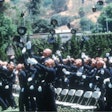On a hot July morning, some years ago, I parked my car in the police academy parking lot at the base of a mountain range skirting the south end of Phoenix, Arizona. I lugged my bags of books, newly pressed uniforms, gun belt, and my physical fitness gear to the locker room.
I was sweating within seconds of exiting my car. It was already over 90 degrees and the July humidity was going to take it’s toll on anyone foolish enough to be outside that day. I knew that the first thing on my plate this morning was physical conditioning, or PT, as it was known. I donned my 80's-style athletic shorts and white cotton T-shirt and fell-in to start morning PT. As luck would have it, my academy sergeant was a runner. A skinny, agile guy that thought running was fun. I was just shy of 200 pounds and more likely to be found in the gym with a set of weights than on the roads in a pair of running shoes. Running was painful, not fun.
Nonetheless, I wanted to be a police officer and I was not going to let a little thing like running 7 miles wash me out of the academy. So I fell into the pack, running behind the nimble Sergeant, up the mountain, down the mountain, across the desert and back to the police academy, 7-miles to the better and 7 pounds of water lighter.
This scenario was repeated almost every workday for five months. PT was a big part of the academy. It was exactly as I expected. I knew I had passed a physical test to get hired, and I knew that those standards would have to be met to graduate and become a police officer. A few months later, I passed the final PT test and graduated to a full-fledged rookie officer-in-training.
Now, back in the '80s when the above scenario was unfolding, we used fitness standards set by the Cooper’s Institute. We had to complete a 1.5-mile run in a certain amount of time, do the prescribed amount of sit-ups and push-ups, and complete an obstacle course designed to simulate what we would be doing on the job. We also talked about different standards for women than men as well. As time passed, the standards have continued to relax to the point where just about anyone should be able to pass and become a police officer.
The women in my academy class performed just as well or better than the men in the class. They had the same standards to meet because they were going to be doing the same job as the men. It made perfect sense. But what about the testing process that everyone had to go through to get hired and sent to the academy? Did the physical testing give undue favor to male applicants?
The debate over male and female physical fitness testing for police hiring was renewed in a very big way this month, almost 30-years after my classmates and I pondered the same question.
The Department of Justice has filed a lawsuit against the Pennsylvania State Police that claims the agency's physical fitness standards for recruits discriminate against women. They have some very solid figures to back up their claim.
The fitness testing pass rates for female and males are strikingly different. I have read something like 94% of men passed and 71% of women passed since 2003.
The DOJ argues that the different pass rates for men and women were evidence the tests had a detrimental impact on women. I agree, those percentages are not something that anyone should ignore. They are red flags being raised to show a process that may not be fair.
I am not going to sit here and say that the Pennsylvania State Police testing is designed to discriminate against female applicants. It is not. And the leadership of the PSP is not trying to keep women out of their fine agency. But there are still those percentages that say something is wrong. The disparity in pass rates for men and women doesn’t warrant a DOJ lawsuit, but it can’t be ignored either.
Whenever there is a systemic failure in a process that appears to be discriminatory, then it’s right to look at the whole process. I’m not talking about modifying the number of sit-ups or pushups that officer-candidates need to do. You look at the standards that have to be met to pass and you scratch your head as to why someone who wants to be a police officer would show up not prepared to do 13 sit-ups in a minute. I’m talking about what happens to get this pool of applicants to the testing process. How did the 29% of females and the 6% of males that can’t pass the fitness test get to the starting line of the 300-meter qualifying run? The answer may lie in the recruiting.
The recruiting function for the PSP is responsible for who shows up to take the physical fitness test. Clearly, there is a greater percentage of men showing up that can pass the fitness test than the percentage of women showing up who can pass. That’s not discrimination, that’s reality. The PSP should look at what they are doing, or not doing to get this collective pool of candidates to the testing process. I doubt it will be an easy answer, but it is clear to me that may be the problem. It’s certainly not the fitness standards.
Fitness standards should not be lowered to accommodate anyone, male or female. The job is the job, and the physical requirements are the same for men and women officers. It’s absurd to propose that women will have an easier time of it on the streets so they can be less fit. That’s like saying the fat officer is jollier, so they don’t have to be fit because they can laugh their way out of a physical confrontation. It’s absurd. The testing standards the PSP uses are not that difficult and I doubt that is the real problem here. The standards are actually easier than some fitness testing standards for local agencies in that state. So what is the problem?
It would behoove the PSP to answer that question because the agency has a lawsuit to deal with. This DOJ suit is an unnecessary distraction, but the leadership of the PSP should have seen it coming. They should have looked at those glaring percentages and tried to figure out how to address the disparity. All agencies should do that. It’s unfortunate that the Pennsylvania State Police has to bear the burden, but you can rest assured that the results of this DOJ lawsuit will be a learning opportunity for many other agencies.
I don’t know what will come of all this, but the PSP will have to do something. Is it in the recruiting section or in the actual physical testing, or both? Either way, everyone should take note of what is happening to the Pennsylvania State Police. Look at your percentages of men and women who are successful in your process. Look at all the demographics, not just sex. Look to see if there are any glaring percentages that may show a problem. Then look at the entire system from the recruiting efforts, to the application and testing and beyond to field training, and retention. The numbers don’t lie.



















